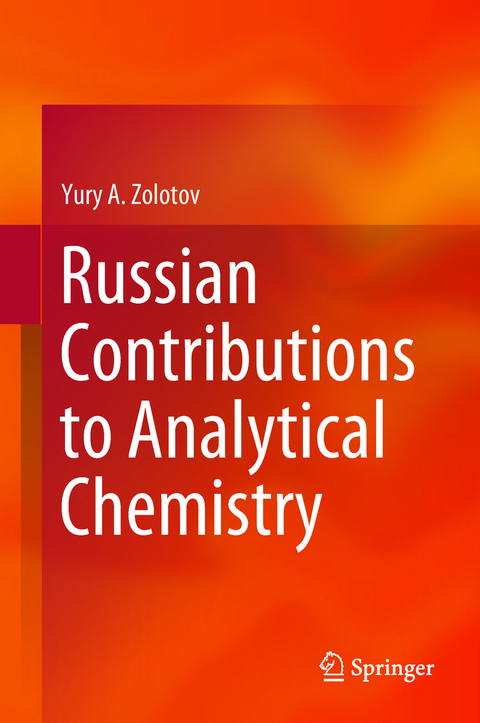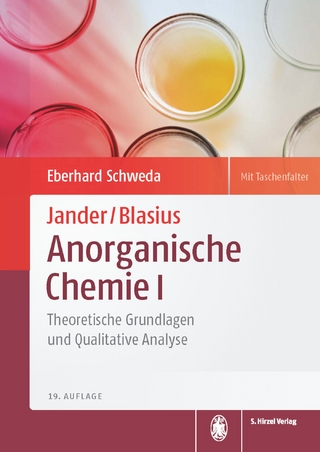
Russian Contributions to Analytical Chemistry
Springer International Publishing (Verlag)
978-3-319-98790-3 (ISBN)
Yury A. Zolotov is the Head of the Department of Analytical Chemistry at Lomonosov Moscow State University, Russian Federation. He is the Editor-in-Chief of the Journal of Analytical Chemistry and the author of several books in Russian, English, German, Japanese and Romanian.
Chapter 1. Spectroscopical methods1.1. General remarks1.2. Electrothermal atomic absorption spectrometry1.3. Fluorescence analysis1.4. Enhanced two-jet arc plasmatron and other works on atomic emission analysis1.5. X-ray polycapillary optics1.6. X-ray radiometric analysis and its applications1.7. Other spectroscopical methodsReferences for Chapter 1Chapter 2. Mass spectrometry and related methods2.1. General remarks2.2. Mass reflectron2.3. Orthogonal entry of a continuous ion beam2.4. Orbitrap: orbital ion trap2.5. Electrospray ionization (ERIAD technique)2.6. Ion-molecular reactions as a path to chemical ionization2.7. Secondary ion mass spectrometry and fast atom bombardment2.8. Atmospheric pressure photoionization2.9. Resonance electron capture negative ion mass spectrometry2.10. In pursuit of ultra-high resolution2.11. Ion mobility increment spectrometryReferences for Chapter 2Chapter 3. Chromatographic methods3.1. General remarks3.2. Birth of chromatography3.3. Thin-layer chromatography3.4. Development of gas chromatography3.5. Liquid-gas chromatography and chromato-membrane methods3.6. Enantioselective ligand-exchange chromatography3.7. Critical chromatography of polymers3.8. Polycapillary and monolithic chromatographic columns3.9. Countercurrent chromatography in inorganic analysis
3.10. Other works on chromatographyReferences for Chapter 3Chapter 4. Electrochemical methods4.1. General remarks4.2. Ion-selective electrodes and electronic tongue4.3. Voltammetry, especially its stripping version4.4. Other achievements in the area of electrochemical methodsReferences for Chapter 4Chapter 5. Chemical methods of analysis5.1. General remarks5.2. Some chemical reactions5.3. Determination of elements using organic reagents5.4. Development of titrimetric methods5.5. Kinetic methods5.6. Other chemical methodsReferences for Chapter 5Chapter 6. Separation and preconcentration methods (apart from chromatography)6.1. General remarks6.2. Methodology of analytical preconcentration6.3. Liquid-liquid extraction6.4. New sorbents and their application to preconcentration6.5. Capillary isotachophoresis and other separation techniquesReferences for Chapter 6Chapter 7. Other methods7.1. General remarks7.2. Stoichiographic method of differentiating dissolution7.3. Method of molecular condensation nuclei7.4. Express tests methods7.5. Elucidation of the structure of organic compounds using spectroscopical data7.6. Semiconductor gas sensors7.7. Some original novel devices and appliancesReferences for Chapter 7Chapter 8. Analysis of specific objects. Analytical chemistry of individual analytes andtheir groups8.1. General remarks
8.2. Nuclear materials8.3. Materials for microelectronics and other high-purity substances8.4. Rare elements, platinum-group metals8.5. Environmental objects8.6. Other analysis objects and analytes8.7. Ensuring the quality of chemical analysisReferences for Chapter 8Chapter 9. Textbooks. Journals. History and methodology of analytical chemistry.Promotion of this science9.1. General remarks9.2. Textbooks and handbooks. Serial publications9.3. Journals9.4. Works on the history and methodology of analytical chemistry9.5. Promotion and popularization of analytical chemistryReferences for Chapter 9Chapter 10. Organizational input10.1. General remarks10.2. Work in international organizations10.3. Work in international journals10.4. Organization of international conferences10.5. Russian researchers abroad10.6. Experience of organizing research in RussiaReferences for Chapter 10
"It provides an outstanding overview of the achievements in analytical science in Russia during the last century, when much of the development remained unrecognized outside the Soviet block. This book might be considered as a reference book for those interested in history of science, in particular analytical science of the twentieth century until now. ... the book is a unique resource to any scientist interested in the development of this field." (Reiner Salzer, Analytical and Bioanalytical Chemistry, Vol. 411, 2019)
“It provides an outstanding overview of the achievements in analytical science in Russia during the last century, when much of the development remained unrecognized outside the Soviet block. This book might be considered as a reference book for those interested in history of science, in particular analytical science of the twentieth century until now. … the book is a unique resource to any scientist interested in the development of this field.” (Reiner Salzer, Analytical and Bioanalytical Chemistry, Vol. 411, 2019)
| Erscheinungsdatum | 16.09.2018 |
|---|---|
| Zusatzinfo | IX, 160 p. 103 illus., 48 illus. in color. |
| Verlagsort | Cham |
| Sprache | englisch |
| Maße | 155 x 235 mm |
| Gewicht | 426 g |
| Themenwelt | Naturwissenschaften ► Chemie ► Analytische Chemie |
| Schlagworte | Analytical chemistry in Russia • Chromatography in Russia • Chromatomembrane Method • History of Analytical Chemistry • Kumakhov X-ray optics • Mass spectrometry in Russia • Russian analytical chemists • Science in Russia • Spectroscopy in Russia • Spolský effect • Spolský effect • stoichiographic method |
| ISBN-10 | 3-319-98790-9 / 3319987909 |
| ISBN-13 | 978-3-319-98790-3 / 9783319987903 |
| Zustand | Neuware |
| Haben Sie eine Frage zum Produkt? |
aus dem Bereich


